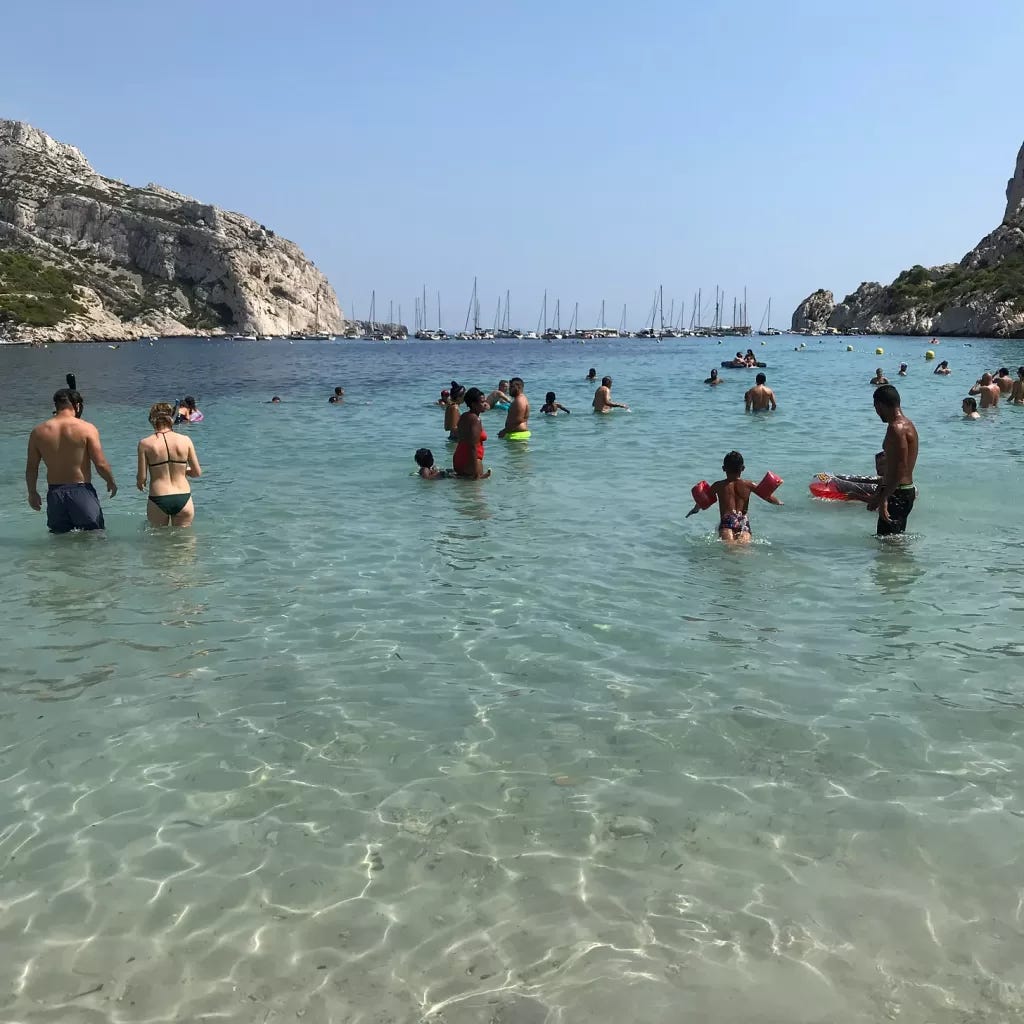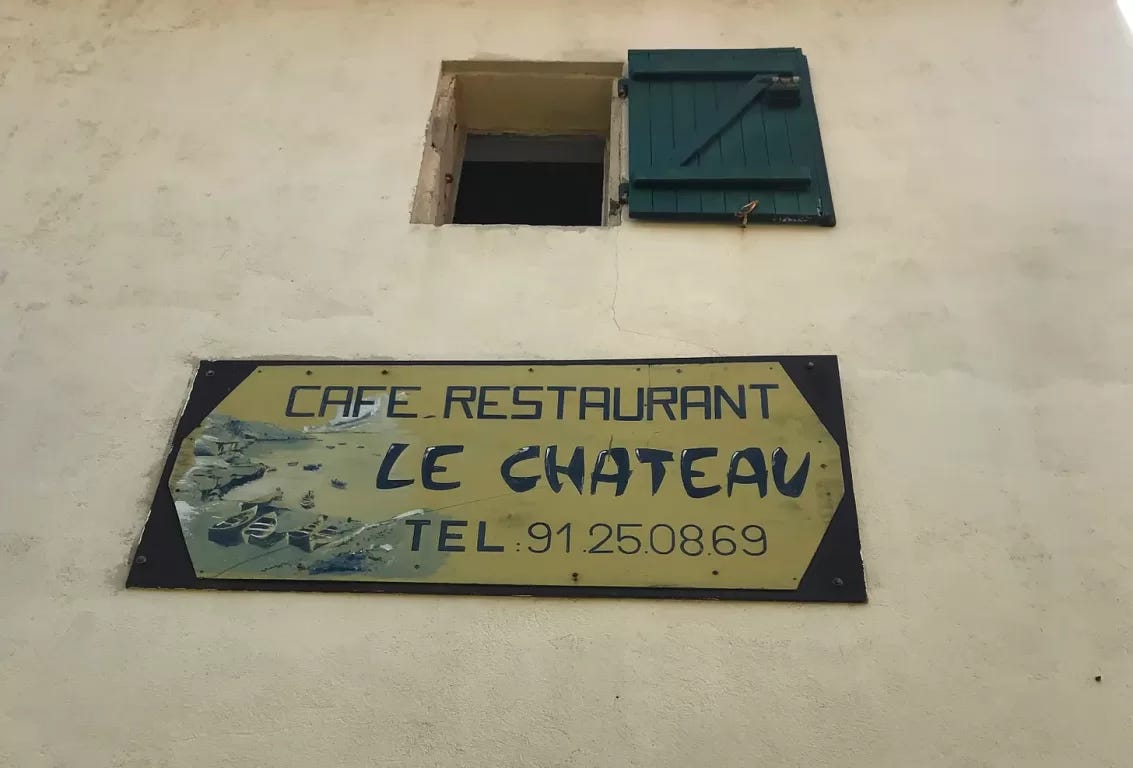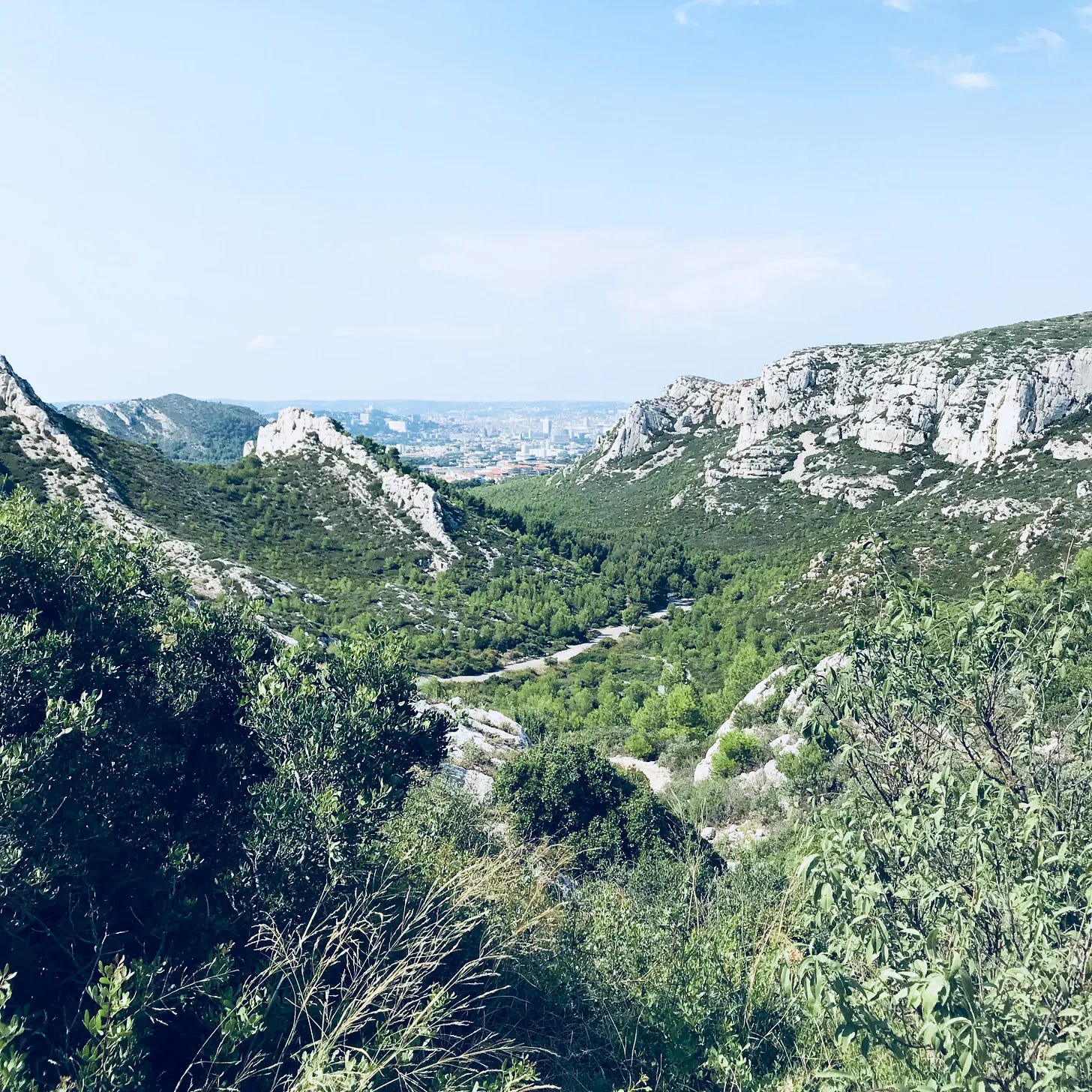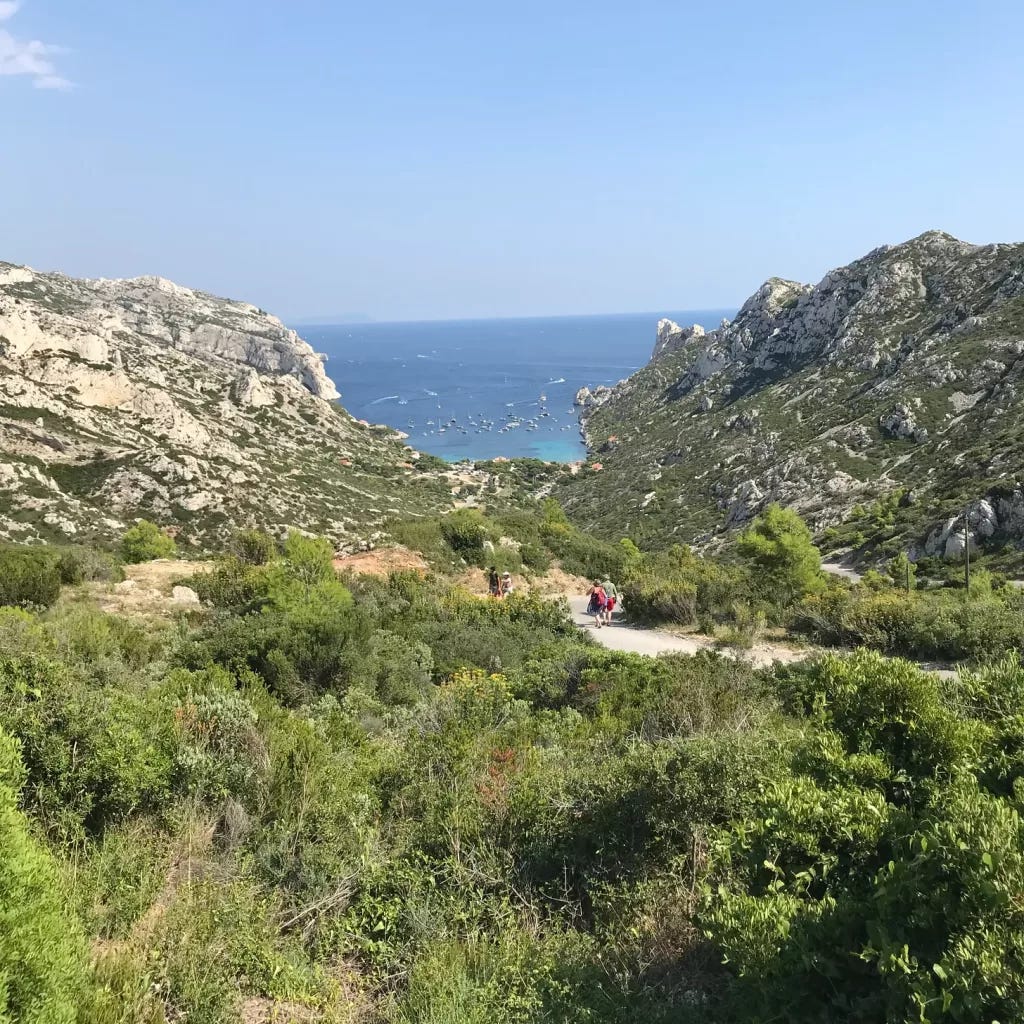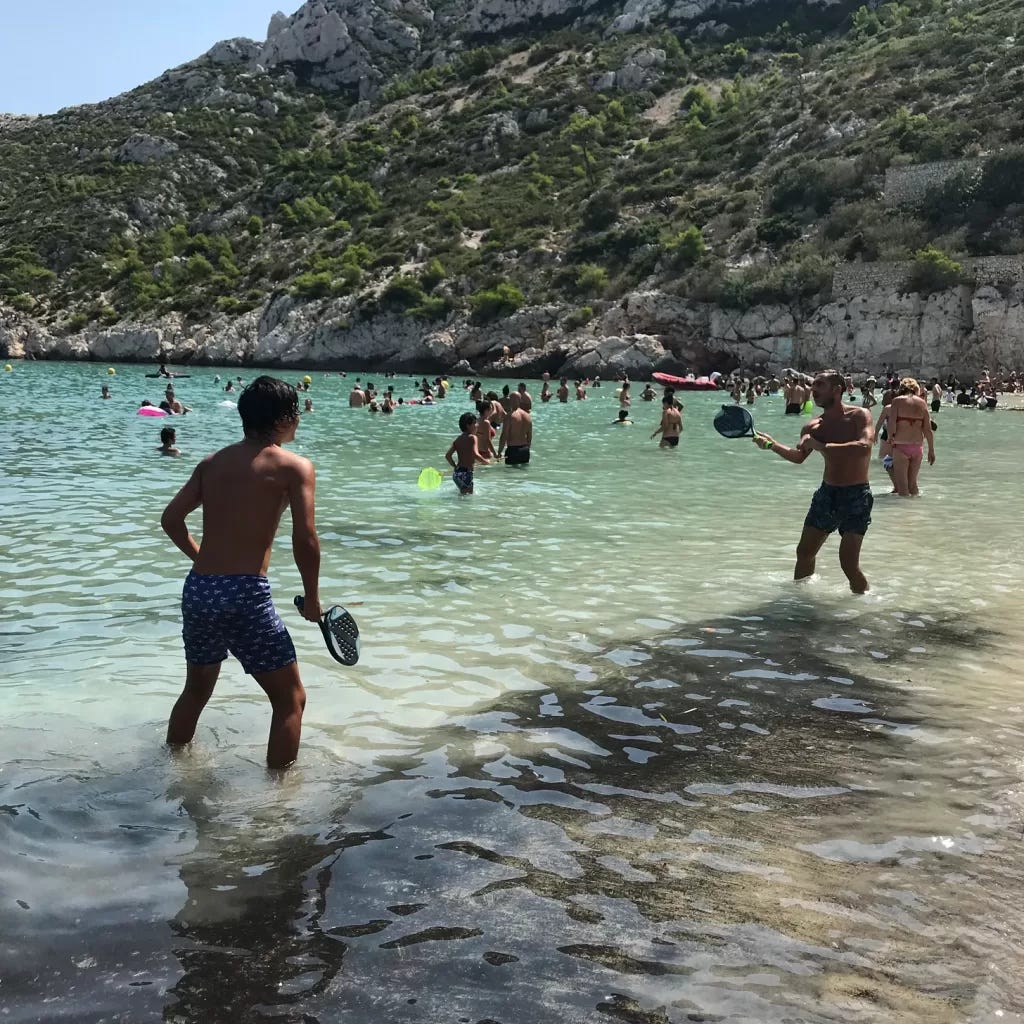A Day at the Calanque de Sormiou, Marseille: A hot walk to a cool beach
It’s a long hot walk but worth every metre…
Looking out to the Mediterranean from the beach at Calanque de Sormiou
Our first visit to the Calanque de Sormiou was a classic case of snatching victory from the jaws of defeat.
Our day started by going down the wrong track, to the wrong Calanque, in the wrong shoes, in 30+ degree heat with an overheating seven-year-old wearing Crocs, until we realised our mistakes (Crocs & route) and had to retrace our steps and start all over again.
But let me take you back a little bit with an idea of what kind of place this is and where we are exactly.
A Calanque (it means ‘steep walled inlet’) is how I would imagine a Fjord to be, but in the south of France, same severe cut into the land like it’s been chopped with a blunt implement, with steep sides, clear sea, and a little beach at the apex. Where the fjord comparison breaks down is the temperature and the smells; I know of no Fjord that’s this warm or smells of Pine, Jasmine and Lavender so strongly.
The Côte Bleue (the south west coast of Provence, west of Marseille) is a bit of a moonscape, the Limestone rock is grey and very jagged but really quite beautiful in its brutal simplicity. And a Calanque, and this Calanque, particularly as it’s one of the most accessible, offers endless possibilities for beachside activity, relaxation, and sharing in general French ‘beachiness’.
We were on our annual camping trip to the south and staying at a Huttopia campsite in Fontvieille, near St Remy de Provence, and the three of us (Myself, Charlotte & Reana), decided to go on a little adventure to the Calanque.
From Fontvieille, it’s an unusual drive through an industrial landscape. With the Marseille skyline in the distance, you travel through what seem like oil fields, but are actually oil storage facilities. We thought it was a Marseille port overspill. It’s an uninspiring landscape, as if France is saving up the good stuff for later.
When you get to Marseille, the Calanque is in the 9th arrondissement. You drive through the university, up a couple of fine-looking boulevards, and voila, you’re at the entrance road. Then it’s a short drive to the gates, where you can either park on the road, or if you’ve booked the restaurant, Le Chateau (details below), you can get waved through to the car park at the beach.
When you’ve parked, the track winds upwards with pines on the right and rocky hills on the left, and takes about 30 minutes to get to the top. When we went the first time, we thought, in our innocence, that it was quite a long walk; little did we know. When you reach the top, just turn around and look back at the incredible view of Marseille in the distance; it’s breathtaking.
But it gets better
What confronts you now looks slightly terrifying, walk down the road and risk death from French driving or follow the nearly vertical rocky path straight ahead of you, the rocky path won for us but you must wear something other than crocs or flip flops or you’ll end up with very sore feet, or a possible broken limb.
The beach from the start of the path down
Although daunting, the walk is 2 km of magical views, smells, and many ‘bonjours’ to the other walkers. Lavender and pine fragrances fill the air as you start the journey down to the sea. The path, which can often seem like a riverbed, the stones that are so smooth and perfectly formed. It’s as if the centuries-old path has been worn down by the 1000’s of feet that have trodden on it and been hammered by endless Mediterranean thunderstorms.
It takes about an hour to get to the bottom, but the path starts to level out about two-thirds of the way down, and you start to see a few small buildings and other ‘South of France’ detritus (if you’ve ever been south, you’ll know what I mean). There’s a car park on the left which always has a lot of cars, which is surprising as the restaurant only sits about 50 people, and as far as I know, making a reservation is the only way to drive down to the bottom, unless you live there.
And then the beach
It’s a magnificent site, surrounded on three sides by Limestone cliffs that dive straight into the sea, it’s a teeming microcosm of Marseille, there’s every nationality imaginable, couples, small families, enormous families and people playing Paddleball, lots of Paddleball.
You could look at the beach and think it’s crowded, a bit like a Gallic sardine can, but you can always find a space for a towel or two and somewhere to lay out your picnic, and somewhere for the kids to go and explore. But it’s the crowds that give this place such a wonderful atmosphere. We loved the sense of community on the beach with everyone sitting, sunbathing, and playing together with such conviviality.
And don’t worry about safety, there are plenty of lifeguards with all the accoutrements of French lifeguarding, floats, paddle-board’s and multiple types of sea-going vehicles ready to grab you if there’s the slightest hint of trouble.
You can just stand in the sea relaxing, like so many people do, or you can explore the underwater caves on the left of the calanque or even book a scuba session on one of the glass-bottom boats in the bay (details below).
Or if you’ve got itchy feet and want to go for a walk, you can go back up the hill about fifty metres and walk along the left of the Calanque and see some of the fishermen’s cottages called Cabanons (there are a couple on Airbnb, link below). If you continue a little further, you get to Port de Sormiou, the next Calanque along, but that’s for another story.
The Calanque de Sormiou is not for the faint-hearted.
The walk, the heat (from May to September), the crowds, not only people but boats, lots and lots of boats, diving, sightseeing and sailing, can seem a little too much at first sight. But it’s so essentially French in its mix of relaxation and activity, all done with a natural bonhomie that we can only admire but can’t hope to emulate.
It’s a great day out for everyone.
Thanks for reading
History
Prehistoric Era
The area around Calanque de Sormiou has been inhabited since prehistoric times, as evidenced by the nearby Cosquer Cave. This underwater cave contains Paleolithic paintings and engravings dating back to 27,000-19,000 BCE, demonstrating early human presence in the region.
Ancient Settlements
The calanque was successively settled by various civilizations:
* Ligurians were among the earliest known inhabitants
* Phocaean Greeks established settlements in the area
* Romans later occupied the region[1]
Medieval Period
By the 14th century, two wells supplied groundwater in the calanque, allowing fishermen to settle permanently. The name “Sormiou” in Provençal dialect means “best source,” referring to these water sources.
19th Century
In 1876, Charles Buret and Augustine Pascalis purchased the calanque at an auction. They later gave it to their daughter Marie as part of her dowry. In 1885, Marie married Count Alfred de Ferry, and the couple became known for their cultural influence in the area.
The Countess of Sormiou
Marie de Ferry, known as the Countess of Sormiou, played a significant role in the calanque’s history:
She frequently visited Sormiou on horseback for picnics and to write odes to its beauty
In 1894, the couple built a summer house known as “the Château”
They constructed 17 cabanons (small cabins) to rent at affordable rates to local inhabitants
Early 20th Century
The early 1900s saw the beginning of leisure activities in the calanque:
Open-air dance halls were erected
The Restaurant du Château was established
A small port for pleasure craft was developed
The UCPA (Union nationale des centres sportifs de plein air) center was built.
World War II and the Birth of Modern Diving
In 1942, Calanque de Sormiou became the birthplace of modern scuba diving:
Georges Beuchat, Albert Falco, and Jacques-Yves Cousteau conducted their first dive with tanks in Sormiou.
The above event laid the foundation for modern underwater diving techniques
Post-War Era to Present
After Marie de Sormiou died in 1956, her great-grandchildren established a property company to manage the cabanons. Today, the calanque’s residents, many of whom are descendants of 19th-century settlers from Mazargues, continue to preserve their cultural heritage in cooperation with the national park authorities.
Amenities
At the end of all my articles, I provide a list of where to access the activities, restaurants, and accommodations I mention in the piece. It’s not exhaustive, but it will give you a good starting point if you want to visit, which I hope you will.
The Restaurant at the beach – call to book and guarantee you can drive down to the beach (as of August 2023, when we last visited)
Le Château de Sormiou
Address: Rte du Feu de la Calanque de Sormiou, 13009 Marseille, France
Phone: +33 6 15 27 26 12
Website:
https://www.lechateausormiou.fr/
Opening Hours: Daily, 12–2:30 PM
Price Range: €€
A well-rated restaurant (4.1/5 stars) offering local cuisine with scenic views
Boat Trips
Bateau Marseille Calanques
Address: 43 Quai des Belges, 13001 Marseille, France
Phone: +33 6 15 27 26
Website:
https://bateaumarseillecalanques.fr/
Opening Hours: Daily, 7 AM–10 PM
Rating: 4.9/5 (219 reviews)
This company offers boat tours to explore the Calanques, including visits to multiple calanques such as Sormiou, Morgiou, and Sugiton
Croisières Marseille Calanques
* Website: https://www.croisieres-marseille-calanques.com/en/
They offer various boat tours, including:
“Essential of the creeks” tour visiting 6 Calanques in about 2 hours
“Essential + swimming” tour that includes a 30-minute swimming stop in one of the calanques
For both scuba diving and boat trips, it’s recommended to book in advance, especially during peak seasons. These operators can provide you with more detailed information about their services, prices, and availability when you contact them directly.
Scuba Diving
DUNE Marseille – Centre de plongée à Pointe Rouge
Address: 7 Port de la Pointe Rouge, 13008 Marseille, France
Phone: +33 4 28 70 89 26
Website:
https://france.dune-world.com/
Opening Hours: Daily, 8 AM–6 PM
Rating: 4.8/5 (1253 reviews)
This diving centre is open year-round and offers a range of FFESSM and PADI training courses. They have comfortable facilities including changing rooms, showers, and a relaxation area. The center uses two semi-rigid boats equipped for snorkelling, free-diving, and scuba diving.
Accommodation at the Calanque
We’ve hunted far and wide and can only find one actual ‘Cabanon’ for rent at the Calanque.
Cabanon on Airbnb
As the Calanque is so near to Marseille, there are endless possibilities for staying nearby
Local Tourist Information
For more detailed information about activities, regulations, and local services, visitors can contact: Parc National des Calanques
Website: https://www.calanques-parcnational.fr/en/sormiou](https://www.calanques-parcnational.fr/en/sormiou
This official website provides up-to-date information on access restrictions, regulations, and maps of the area.
Important Notes
Access to motorized vehicles in the Sormiou calanque hamlet is limited. Visitors are encouraged to use public transportation or hike to the location.
The calanque can be overcrowded in summer, especially on weekends.
Visitors should respect the site by not leaving waste, creating noise pollution, or parking outside authorised areas.
The GPS coordinates for Calanque de Sormiou are 43.210689, 5.419993.
Remember to check the latest information and book activities in advance, especially during peak seasons, to ensure availability and the best experience at Calanque de Sormiou.
I hope you enjoy the Calanque de Sormiou as much as we did.
Nick
Introducing Contributor, Nick Garnett:
Visit her Contributor Page — Explore more of Nick’s work


